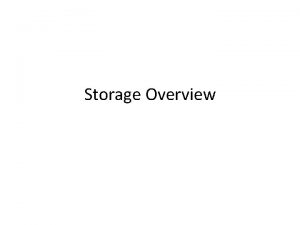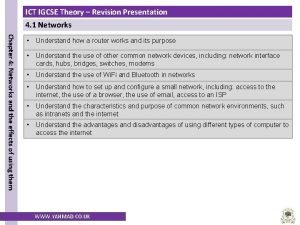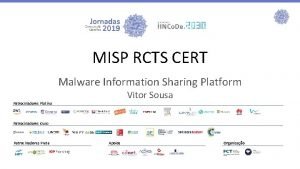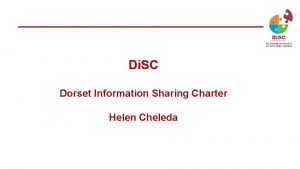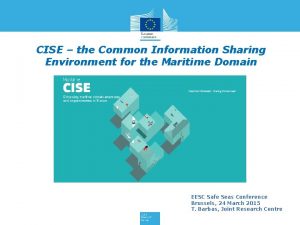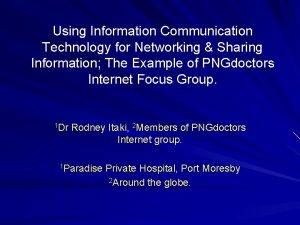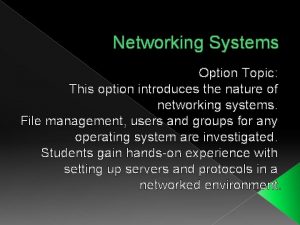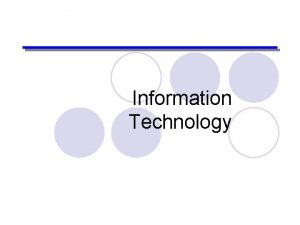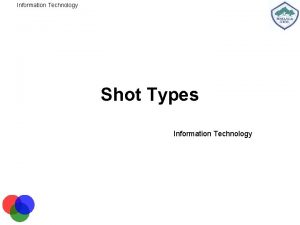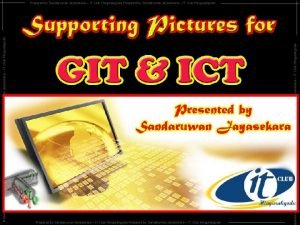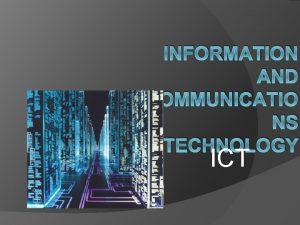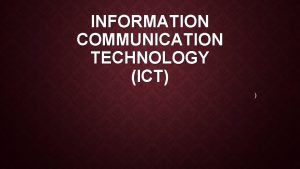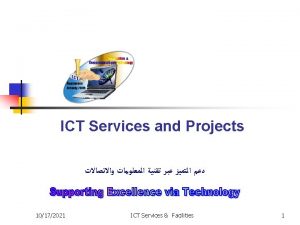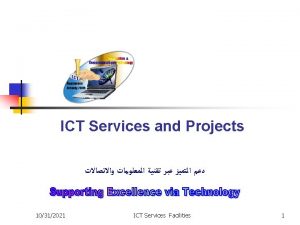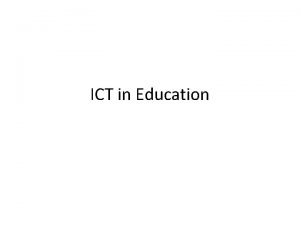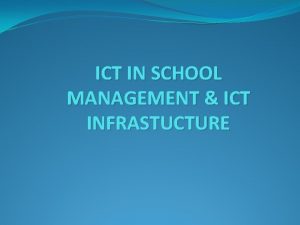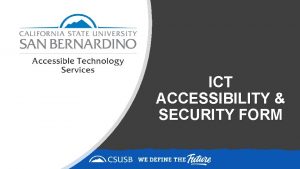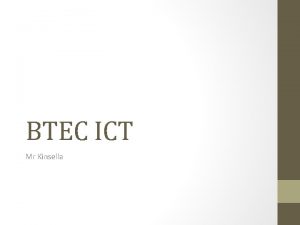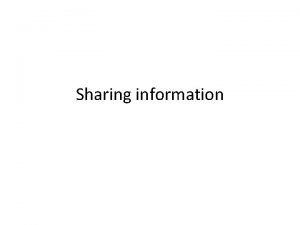Technology ICT Option Networks Networks Networking sharing information

























- Slides: 25

Technology ICT Option: Networks

Networks Networking - sharing information and resources Computers connected to a network can: • Share a printer or a plotter among several users • Share files with other users • Share an Internet connection • Share a folder for central storage of student assignments etc. The two main network types are: • Peer networks - organised as Workgroups. Members simply share their resources with their peers. They are: • • • Relatively inexpensive to set up Easy to set up No special software is required No central storage is provided They have poor security

Networks • • Client server networks - in these networks, Dedicated Servers control Log In and access to resources User Level access applies here Every user has a User Account and must supply a Username and Password to get access to the network Permissions are applied to user accounts and these control access to resources Their main features are: • They have excellent security • Central storage of assignments • Expensive dedicated hardware (server) is required • Expensive dedicated networking software and user licenses required. • A fee called a client access license (CAL) must be paid for each client connecting to the server. • A network administrator is required

Networks Local area networks (LAN) • Computers connected together in a single location • Vary in size from two computers connected together to share a printer or Internet connection, to several computers connected over multiple floors of a building • Computers connected using some form of cable (or wireless) and all the components of the LAN will be owned locally • Network devices are called Nodes. (computer, printer etc. )

Networks Wide area networks (WAN) • In a wide area network, the network extends beyond the confines of a single building or buildings and some form of telecommunications must be used to connect the computers • All the network components will not be owned locally • The Internet is the largest WAN in existence

Networks Topology refers to the physical layout of the network - how the network is cabled. The Ethernet standard is used in most networks: • Star topology - In a star topology, each computer is cabled to a central switch. A switch is like a junction box and when a computer sends a signal, the switch sends it to the relevant computer(s) on the network

Networks Specifications • Maximum cable (segment) length is 100 metres from a computer to a switch Advantages of the Star topology: • Easy to troubleshoot as LED’s on the front panel of the switch show the status of each computer connected to it • Expansion is easy as you just cable a new computer to the switch. If all the ports on the switch are used, a higher capacity one can be used or a second switch can be stacked on top of the first one and linked to it • Damaged or loose cables only isolate the specific computers and the network continues working Obviously, switch failure will stop the network from working

Networks Network Media Network media can be divided into 2 categories: • Network interface cards (NIC’s) • Cables 1. Network interface cards: Network cards usually fit into slots on the Mainboard of the computer. They are categorised by: • Type (PCI, USB or PC-Card) PCI Wireless PCI PC-Card USB

Networks • The type of cable they support • Their data transfer rate • • Fast Ethernet - 100 Mbps using UTP Gigabyte Ethernet - 1000 Mbps using UTP

Networks 2. Network cables Several factors affect the choice of cable for a particular network installation: • The distance between computers • The physical environment in which the cables must operate (electrical interference) • The type of network being installed Copper and aluminium are used in network cables because they are good conductors This is also their downfall as they can conduct signals (RF noise) from electric wiring etc. and this interferes with the data being transmitted on the network Because of this, methods of shielding the copper and aluminium wire have been developed

Networks Twisted pair cable - works on the principle that two conductors wrapped or twisted around each other generate a field that protects them from RF noise. The degree of twisting on each pair is varied along it’s length to reduce crosstalk between the pairs. There are two main types: • Shielded Twisted Pair (STP) • Unshielded Twisted Pair (UTP) Shielded twisted pair - each twisted pair is insulated using metal foil to reduce crosstalk. The shielded pairs are encased in a second shielding layer to reduce RF noise and finally, an outer plastic jacket is added to protect the cable from damage. This is expensive cable and it is difficult to install. It is only used where UTP is unsuitable

Networks Unshielded twisted pair (UTP) - is nowadays the most common network cable in use. Category 6 UTP is the modern standard. It uses four pairs of twisted wires covered with a plastic jacket. It is susceptible to RF noise which limits it’s data transmission speed and maximum cable length. and so shouldn’t be laid over fluorescent lights or in conduits along with electric wires. It’s main features are: • The cheapest cable • The maximum length of a single cable is 100 meters • Maximum data transmission rate is 1000 Mbps • Susceptible to RF noise • Switches are required

Networks Fibre optic cable - transmit s data as light pulses instead of electrical pulses. As a result, they are immune to crosstalk and RF noise. Because of this, signals travel further Features: • Immune to crosstalk and RF noise • Provides secure data transmission • Very expensive (up to ten times more expensive than UTP) • Difficult to install as cable can easily be damaged by bending • Single cable can extend for several kilometres Fibre core Insulation Kevlar Shield Jacket

Networks Wireless networks - allow you to connect your computers without the need for cables They offer the same flexibility as mobile phones, but are currently restricted to approximately 50 metres radius from the transmission switch (Access Point) They can be used to link PC’s, Laptops or a combination of both They can be linked to form a full wireless LAN or linked to an existing Ethernet LAN (hybrid network) Technically, there are two types of wireless transmission: • Infrared (IR) - devices must have line of sight between them as infrared signals can’t penetrate solid objects, including people. For this reason, infrared tends to be used for wireless mice, keyboards etc • Radio frequency (RF) - Radio frequency devices don’t need line of sight as radio waves can penetrate solid objects. This makes them much more suitable for LAN’s

Networks Wireless standards IEEE 802. 11 is the standard used for wireless LAN’s This originally had a transmission speed of 2 Mbps More recently, a range of new standards have appeared When buying wireless LAN devices, make sure that they follow the IEEE 802. 11 standards as this will offer most flexibility and there is a much wider choice available Use single protocol devices if possible

Networks Wireless LAN operation At their most basic, a wireless LAN can be two computers fitted with wireless network interface cards for communication with each other when they are in range This is called an Ad Hoc wireless LAN and is the equivalent of an Ethernet Peer to Peer LAN Other computers can join the LAN as they come into range The network interface card set up is similar to that for standard Ethernet and each card comes with it’s own network set up software

Networks A more common use of wireless LAN would be to connect it to an existing Ethernet Server or an Ethernet LAN to produce an Infrastructural LAN A device called an Access Point (Ethernet Bridge or Base Station) connects to the Ethernet LAN and provides access for the wireless computers It is possible to connect in excess of 30 computers to an access point Access points can be connected to each other to extend the network

Networks Finally, a Directional Antenna can be used to link wireless LAN’s over large distances ( up to several kilometres) This could be used to link schools together or to link campus buildings The connection software to enable communication between the client computer and the access point is loaded on the client computer as well as the software driver for the network card

Networks LAN EXPANSION Electrical signals weaken over distance This is called Attenuation and it limits the length of cable a signal can travel through before it becomes unusable Interference from electrical installations etc. also effect the distance If you want a signal to travel over a longer distance, the signal must be repeated and retransmitted. LAN expansion will either involve adding more computers etc. to your existing network or combining smaller LAN’s (Segments) to form larger ones Many devices are available: • • • Hub Switch Router

Networks Hub At their simplest, hubs are basically multiport repeaters Each computer on the network connects to the hub When a computer on the network transmits data, it travels along the UTP cable to the hub The hub simply broadcasts the signal to all the computers on the network Hubs are available in a number of capacities ranging from 4 -port to 24 -port They can also be stacked to increase capacity LED’s on the front of the hub indicate the status of each port They should not be used in a modern network Hub

Networks Switch A switch is basically a clever hub They are available with varying port numbers and can be stacked A switch keeps a table of the destination address of each computer connected to it It doesn’t broadcast data to all computers like a hub would, it instead only sends the data to the computer whose destination address is in the data Switches greatly reduce the amount of network traffic Switch

Networks Routers are used to connect multiple networks (Internet) They choose the best path for the data through the networks Routers keep tables (routing tables) of other routers on the Internet When a router receives data, it consults it’s table and works out the best route for the data to it’s destination

Networks Network Protocol A Network Protocol is a set of rules defining the method of communication between the computers on the network or between networks The protocol controls how data is split up, addressed and how it is transmitted over the network(s) The Ethernet standard is usually used with Microsoft Networking and TCP/IP is the protocol used: • TCP/IP - this protocol suite is the most common suite in use today. The Internet uses TCP/IP so it must be installed to use the Internet. It also allows different computer types to communicate - so, PC’s, UNIX, LINUX and Mac’s can all communicate with each other

Networks Configuring TCP/IP To get TCP/IP to work properly, you need to set an IP Address and a Subnet Mask. The addresses are written in a notation called Dotted Quad - (xxx. xxx)

Networks • IP Address - identifies the computer on the network. Each computer on the network must have a unique IP address. 192. 168. 0. 1, 192. 168. 0. 2, 192. 168. 0. 3, 192. 168. 1. 4 etc • Subnet Mask - identifies the network your computer is on. Computer son the network must have the same subnet mask - 255. 0 • Default Gateway - the IP address of the Router. This address will be used for Internet access through the network. When a computer requires Interned access, it will use this address to contact the router and the router will supply the connection to the Internet • DNS - every web site is known to computers by it’s IP address but we know them by there Domain Name System name. DNS is a database used to link the domain name (www. t 4. ie) to it’s actual IP Address (32. 195. 130. 32). It is basically the Internet’s phonebook
 Bssd adalah
Bssd adalah Option a option b
Option a option b Sdn architecture vs traditional network
Sdn architecture vs traditional network Optical networking technology
Optical networking technology Storage networking technologies
Storage networking technologies Ict chapter 4
Ict chapter 4 Information centric networking
Information centric networking 7 golden rules to share information
7 golden rules to share information Diverse information sharing through universal web access
Diverse information sharing through universal web access Training ground rules
Training ground rules Misp event
Misp event Trends in ict assistive media examples
Trends in ict assistive media examples Secure information sharing
Secure information sharing Misp malware information sharing platform
Misp malware information sharing platform Sharing
Sharing Common information sharing environment
Common information sharing environment Difference between datagram and virtual circuit approach
Difference between datagram and virtual circuit approach Basestore iptv
Basestore iptv What is information in ict
What is information in ict Definition of computer
Definition of computer Positive and negative impacts of materials technology
Positive and negative impacts of materials technology Negative impacts of environmental technology
Negative impacts of environmental technology Volvo information technology ab
Volvo information technology ab User acceptance of information technology
User acceptance of information technology Conclusion on ict
Conclusion on ict Media literacy venn diagram
Media literacy venn diagram




